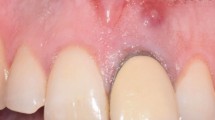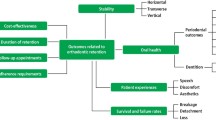Key Points
-
Become familiar with evidence to support popular regimes used before carrying out endodontic surgical procedures.
-
Be provided with a brief review of interventions used to reduce symptoms following endodontic surgery and an assessment of their evidence base.
-
Find a discussion of popular pre- or postoperative protocols, instructions, advice and management techniques that lack any researched basis.
Abstract
In the last of this series of articles, the author will review some of the current interventions and advice that is most commonly used before and following endodontic surgical procedures. The aim of this article is to review the current evidence in the literature to support or refute current practices, management methods and protocols. The relative strength of the research discussed – including strengths and weaknesses – will be commented on. There are also some medicaments and instructions in dentistry that have no researched basis; some of these will also be identified and discussed.
Similar content being viewed by others
Introduction
There are many reasons why orthograde root treatment may not be successful1,2 and practitioners are able to consider endodontic surgery (Fig. 1) as a treatment option in many instances.3,4,5 Recent figures for endodontic surgery have outlined much improved healing outcomes.6,7,8,9,10
These promising statistics are not independent of the high quality, meticulous pre- and postoperative care that is so important in patient management, as well as the success of a particular treatment. Over the years, oral surgeons have devised and implemented many methods to improve the outcome of endodontic surgery for patients both within the procedure and the time period that follows (short and long-term). Some of these practices are physically able to be carried out or utilised by the surgeon, whereas others require the patient to take responsibility for the execution or implementation. Although many of the techniques and protocols selected have some form of evidence to support their use, some are 'tried and tested'. This article will highlight some of these commonly used pre- and postoperative instructions.
Preoperative
Antibiotics
The uses of antibiotics have been well-discussed in the previous article in this short series.11 Operators will know well that their application is often applied possibly more frequently in oral and maxillofacial surgery than other dental specialities.
Antibiotics can be given preoperatively, before endodontic surgery being carried out, and there has been interest in their uses for endodontic surgery.12,13,14 This interest originated in 1989, when High and Russell explored the use of antibiotic-containing (Gentamycin) cement as a retrograde restorative material, alternatively to amalgam.12 This material exhibited superior bactericidal qualities to amalgam; however, the entire study was in vitro and there was no observation of direct benefits to patients. Some authors were interested in the immunological reaction post-surgery in patients who had been given antibiotics preoperatively.13 Although this particular investigation concluded a reduction in immune activation with preoperative antibiotic prescription, the design of the study is questionable. Only 23 patients were studied 17 of whom received no antibiotic therapy. Of the six patients who did receive prophylactic antibiotics, there is no mention of what was prescribed or how it was delivered. Also, the immunological activation was measured via urine markers, not clinically, which may cause readers to question the validity of the conclusion.13 The author's thoughts are similar to that of Carrotte: that antibiotic therapy is rarely required for routine endodontic surgical procedures,5 but this may need to be tailored to the circumstances of individual patients, in particular where risk factors for complications are apparent (see part 1 in this series15).
The most relevant evidence from the literature is a strong study by Lindeboom and co-authors.14 Their randomised-controlled, double-blinded study was performed prospectively. The authors used clindamycin (600 mg) or placebo preoperatively in 256 patients and continued observation of the surgical site up to four weeks postoperatively. Two infections were recorded postoperatively in the group of patients who'd received clindamycin, compared to four patients who had received the placebo alternative. As a result no statistically significant difference was recorded.4 Unfortunately, this study only focused on the use of clindamycin as the antibiotic of choice and it remains unknown if alternative antibiotic therapies would produce differing results. According to current UK clinical guidelines, clindamycin is not a recommended 'first-line' antibiotic in dentistry.16,17 A more recent study, analysing longer-term healing outcomes following endodontic surgery, confirmed the lack of benefit with the prescription of antibiotics one-year postoperative.18
The use of Chlorhexidine Gluconate mouthrinses
Although recent NICE guidelines would discourage the use of chlorhexidine mouthwash as prophylaxis to developing certain heart conditions,19 an excellent recent article in this Journal confirmed the benefits of using chlorhexidine gluconate (0.2%) for one minute as a preoperative rinse, preventing infection of the surgical site.3 The oral rinse is one of the most popular products used in dentistry and 10.2% of drug prescriptions issued by the GDP are for chlorhexidine gluconate (0.2%) oral rinse.20
Following the early work by Martin in 1987,21 a prospective study evaluating postoperative pain and swelling following surgical endodontic treatment is relevant.22 Here the authors administered chlorhexidine gluconate mouthwash twice daily for patients three days preoperatively, and continued use for seven days postoperatively. The results of this study demonstrated that over 75% of patients were symptomless one-day postoperatively. This would seem encouraging, but this study has several weaknesses: there is no control group, some patients were also given antibiotics (that may have contributed to the large number of symptomless patients) and also a longer period of follow-up may yield more relevant results.22
Although chlorhexidine gluconate (0.12% and 0.2%) are used so commonly in both primary and secondary care, future research may advocate increased caution with their use. Recent reports have revealed two cases of death via anaphylaxis following the use of chlorhexidine gluconate post-extractions in tooth sockets.23 These incidences may have put clinicians on alert with regard to the use of these products routinely and perhaps even cause some to consider halting their use completely.
Postoperative
Swelling and wound care
The diligent clinician will be all too aware that a vital milestone within the patient's holistic care is the point where the patient themselves is made responsible for their own postoperative care and whether or not they follow advice, instruction or clinical guidance is often out of the hands of the operator. It is the view of the author that the majority of patients will be keen to follow direction in order to avoid complications and outcomes of treatment will then incur a share responsibility.
Swelling is a well-recognised postoperative manifestation and has been thoroughly investigated with endodontic surgical procedures.24,25,26,27 The use of ice packs to reduce the risk of postoperative swelling has been discussed perhaps more in relation to wisdom teeth28 (see part 2 in this series11), but has also been advocated in endodontic surgery.29 The Royal College of Surgeons (Eng) dental faculty suggests that application of an ice pack 4-6 hours post-surgery minimises postoperative swelling.30 Currently, no data exists to study whether this has any significant impact in postoperative pain, but the findings of Chong and Pitt Ford were that non-prescription analgesia provided adequate relief in symptoms following endodontic surgery in two treatment groups who received different root-end filling materials.31 This study also concluded that pain was experienced early in the postoperative period and decreased in intensity with time. A similar outcome is proposed for swelling: that this is worst 24-48 hours post-surgery.32 Rhodes suggests the application of an ice pack for 20 minutes in each hour throughout the day during the day of surgery.32 There is also evidence to suggest that pain and swelling is more severe in patient with poor oral hygiene and those that smoke.27
The use of chlorhexidine gluconate has already been discussed preoperatively (see above), but it also remains popular postoperatively, particularly for wound care. When discussed in relation to endodontic surgery performed in the modern day, it is recommended for use twice daily for one minute, around the surgical site.21 Its use is recommended particularly at the surgical site, as tooth brushing here is often not possible, and chlorhexidine gluconate mouthwashes do demonstrate evidence to suppress the formation of dental plaque.33
The removal of sutures in endodontic surgery can carry particular importance as their prolonged presence has been associated with a 'wicking' effect'30,34 (Fig. 2). One animal study divided rabbits into three groups, raised a mucoperiosteal flap and then repositioned this. Sutures were removed at three, five and seven days (respective to the groups) and the investigators demonstrated significant differences between the groups to recommend the removal of sutures after five days.35 This has been strongly refuted by other studies, which suggest sutures may be removed after 48 hours, but should not be allowed to remain post-96 hours.36,37,38,39 In microsurgical procedures, this figure is reduced further, with some authors advising removal of surgical sutures after only three days.4
Other advice, instruction and protocols
For many of the protocols, instructions and advice provided, some form of evidence exists, but this can be misleading and/or flawed with weaknesses and busy practitioners will always benefit from organisations that provide guidelines for common procedures, some of which are used every day.16,17,19,20,30,40,41
Having reviewed some common advice and instructions in common oral surgery procedures, operators will only be too aware there is still an abundance of advice and instruction without any form of direct evidence. Many of these instructions make clinical sense, but carry no firm researched foundation.
Some examples of these can be discussed: many clinicians will advise patients to avoid exercise or strenuous activity following surgery, when actually little or no direct evidence exists in dentistry, particularly relating to procedures discussed above. Another example would be the encouragement of a 'soft diet' following surgical procedures - again, this makes practical sense and it would seem counter-productive to pursue an alternative recommendation, but no high quality clinical trials exist to provide foundation for this advice.
With regard to endodontic surgery, as well as the postoperative wound care discussed (see above), patients are advised to avoid brushing/rinsing the area too vigorously. Again, the force and nature of cleaning methods has not been investigated up to date - yet most operators would agree this advice is sensible. One of the most popular instructions (in particular related to the two oral surgery procedures described above) is to instruct patients to use 'warm salt water mouthwashes' (WSWM) postoperatively, especially after meals. In relation to endodontic surgery, this particular piece of advice has even been included in a document available via the British Association of Oral Surgeons.42 Advocating the use of WSWM as a postoperative instruction has probably been advised and delivered for many years; and there is little reason to question it when there would seem to be little harm induced by encouraging the use of WSWM, but it is another instruction that is given, with minimal input from the literature to provide support for the use of WSWM.
Summary
As mentioned briefly in the first of these articles, the delivery of the advice, instructions and protocols that are provided to patients is as important as the content of what is delivered. Only this holistic approach can ensure that the requirements of consent within the profession are met,43 and patients are given the information they want and need.
As clinicians there is a responsibility to not only realise and be aware of what should be advised/not advised, what instructions to provide and which protocol to follow, but there must also be recognition of where this information has been derived and its relative reliability. A sound knowledge of this information, coupled with a thorough and meticulous history and examination, will aid clinical decision-making, enable appropriate consent to be gained and help support patients who have questions or wish to request information in relation to their healthcare.
References
Carrotte P . Endodontic problems. Br Dent J 2005; 198: 127–133.
Nair P N . On the causes of persistent apical periodontitis: a review. Int Endod J 2006; 39: 249–281.
Chong B S, Rhodes J S . Endodontic surgery. Br Dent J 2014; 216: 281–290.
Eliyas S, Vere J, Ali Z, Harris I . Micro-surgical endodontics. Br Dent J 2014; 216: 169–177.
Carrotte P . Surgical endodontics. Br Dent J 2005; 198: 71–79.
Del Fabbro M, Taschieri S, Testori T, Francetti L, Weinstein R L . Surgical vs. non-surgical endodontic re-treatment for periradicular lesions. Cochrane Database Syst Rev 2007; 18: CD005511.
Chong B S, Pitt Ford T R, Hudson M B . A prospective clinical study of Mineral Trioxide Aggregate and IRM when used as root end filling materials in endodontic surgery. Int Endod J 2003; 36: 520–526.
Saunders W P . A prospective clinical study of periradicular surgery using Mineral Trioxide Aggregate as a root-end filling. J Endod 2008; 34: 660–665.
Tsesis I, Faivishevsky, Kfir A, Rosen E . Outcome of surgical endodontic treatment performed by a modern technique: a meta-analysis of the literature. J Endod 2009; 35: 1505–1511.
Setzer F C, Shah S B, Kohli M R, Karabucak B, Kim S . Outcome of surgical endodontic treatment performed by a modern technique: a meta-analysis of the literature – Part 1: Comparison of traditional root-end surgery and endodontic microsurgery. J Endod 2010; 36: 1757–1765.
Mansoor J . Part 2: Before and after – the removal of wisdom teeth. Br Dent J 2015; 218: 279–284.
High A S, Russell J L . Retrograde root filling using antibiotic-containing, radiopaque, bone cement. J Dent 1989; 17: 241–245.
Anderssen C, Bernhart T, Honlinger M, Mailath G, Wachter H, Fuchs D . Immune activation after apicoectomy: comparison between patients with and without prophylaxis antibiotic therapy. Pteridines 2003; 4: 192–194.
Lindeboom J A, Frenken J W, Valkenburg P, van den Akker HP . The role of preoperative prophylactic antibiotic administration in periapical endodontic surgery: a randomised, prospective double-blind placebo-controlled study. Int Endod J 2005; 38: 887–881.
Mansoor J . Part 1: Minor oral surgery – before and after where is the evidence? Br Dent J 2014; 218: 273–278.
Scottish Dental Clinical Effectiveness Programme. Drug prescribing for dentistry, 2nd ed. NHS Scotland, Dundee Dental Education Centre UK, 2011.
Faculty of Dental Practitioners (FGDP). Antimicrobial prescribing for general dental practitioners, 2nd ed. London: FGDP, 2012.
Von Arx T, Hanni S, Jensen S S . Clinical and radiographic assessment of various predictors for healing outcome one year after periapical surgery. J Endod 2007; 33: 123–128.
National Institute of Clinical Excellence (NICE). Prophylaxis against infective endocarditis, 1st ed. London: NICE, 2008.
Dental and Eye Care Team; Prescribing Support Unit. Prescribing by dentists, 2010. London: National Information Centre, 2011.
Martin M V, Nind D . Use of chlorhexidine gluconate for pre-operative disinfection of apicectomy sites. Br Dent J 1987; 162: 459–461.
Tsesis I, Fuss Z, Lin S, Tilinger G, Peled M . Analysis of postoperative symptoms following surgical endodontic treatment. Quintessence Int 2003; 34: 756–760.
Pemberton M N, Gibson J . Chlorhexidine and hypersensitivity reactions in dentistry. Br Dent J 2012; 213: 547–550.
Garcia B, Larrazabal C, Penarrocha M, Penarrocha M . Pain and swelling in periapical surgery. A literature update. Med Oral Patol Oral Cir Bucal 2008; 13: E726–E728.
Penarrocha M, Garcia B, Marti E, Balaguer J . Pain and inflammation after periapical surgery in 60 patients. J Oral Maxillofac Surg 2006; 64: 429–433.
Kvist T, Reit C . Postoperative discomfort associated with surgical and nonsurgical endodontic retreatment. Endod Dent Traumatol 2000; 16: 71–74.
Garcia B, Larranzabal C, Penarrocha M, Penarrocha M . Pain and swelling in periapical surgery: a literature update. Med Oral Patol Oral Cir Buccal 2008; 13: E726–729.
Sortino F, Cicciù M . Strategies used to inhibit swelling following removal of impacted lower third molar. Dent Res J (Isfahan) 2011; 8: 162–171.
Gutmann J L . Surgical endodontics: post-surgical care. Endod Topics 2005; 11: 196–205.
Evans G E, Bishop K, Renton T . Guidelines for surgical endodontics, 2nd ed. Royal College of Surgeons (England). Fac Dent Surg 2012: 5–6.
Chong B S, Pitt Ford T R . Postoperative pain after root-end resection and filling. Oral Surg Oral Med Oral Pathol Oral Radiol Endod 2005; 100: 762–766.
Rhodes J S . Advanced endodontics: clinical retreatment and surgery, 1st ed. Oxfordshire: Taylor & Francis, 2005.
Löe H, Schiott C R . The effect of mouthrinses and topical application of chlorhexidine on the development of dental plaque and gingivitis in man. J Periodontal Res 1970; 5: 79–83.
Harrison J, Jurosky K, Wound healing in tissues of the periodontium following periradicular surgery. I. The incisional wound. J Endod 1991; 17: 425–435.
Parirokh M, Asgary S, Eghbal M J . The effect of different suture removal time intervals on surgical wound healing. Iran Endod J 2006; 1: 81–86.
Gutmann J L, Harrison W H . Flap designs and incisions. In Gutmann J L, Harrison W H (eds). Surgical endodontics. pp 162–175. St. Louis, Missouri: Ishijaku EuroAmerica, Inc., 1994.
Selvig K, Torabinejad M . Wound healing after mucoperiosteal surgery in the cat. J Endod 1996; 22: 507–515.
Wirthlin M R, Hancock E B, Gaugler R W . The healing of atraumatic and traumatic incisions in the gingivae of monkeys. J Periodontol 1984; 55: 103–113.
Grung B . Healing of gingival mucoperiosteal flaps after marginal incision in apicoectomy procedures. Int J Oral Surg 1973; 2: 20–25.
World Health Organization. Post-operative pain relief. 2014. Available at: http://www.who.int/surgery/publications/Postoppain.pdf (accessed 18 May 14).
National Institute for Clinical Excellence (NICE) technology appraisal guidance number 1. Guidance on the extraction of wisdom teeth. 2000.
British Association of Oral Surgeons. Apicectomy. 2014. Available at: http://www.baos.org.uk/resources/Apicectomy1.pdf (accessed 3 November 2014).
General Dental Council. Standards for the dental team. 2013.
Author information
Authors and Affiliations
Corresponding author
Additional information
Refereed Paper
Rights and permissions
About this article
Cite this article
Mansoor, J. Pre- and postoperative management techniques. Part 3: Before and after — Endodontic surgery. Br Dent J 218, 333–335 (2015). https://doi.org/10.1038/sj.bdj.2015.196
Accepted:
Published:
Issue Date:
DOI: https://doi.org/10.1038/sj.bdj.2015.196
This article is cited by
-
Post-operative instructions following minor oral surgery - the quality and level of evidence: a cross-sectional study
British Dental Journal (2020)





